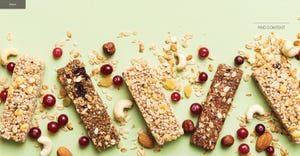Manufacturers have an opportunity to provide innovative products that deliver fiber, as well as communicating to consumers the myriad reasons they should want more fiber in their diets.

Dietary fiber, also referred to as roughage or bulk, is the structural part of plant foods (such as grains, fruits or vegetables) that the human body cannot break down or digest. Instead, fiber passes through the body undigested.
The two basic types of fiber are:
• Soluble fiber, which dissolves in water and forms a gummy gel-like substance that can slow down the movement of food from the stomach to the intestine.
• Insoluble fiber, which does not dissolve in water. Rather, it holds onto water, which helps move food through the digestive system where it can help regulate intestinal issues.
A diet rich in fiber is associated with many potential benefits and may serve to reduce the risk of several health concerns. On the flip side, a fiber deficiency can negatively affect health in numerous ways by increasing the possibility of various issues.
How much fiber is enough?
A “Fiber Fact Sheet” article on the International Food Information Council (IFIC) website noted the adequate intake (AI) level for fiber recommends adults under age 50 consume about 25 grams (for women) to 38 grams (for men) of total fiber per day. As people age, their fiber requirements decrease, and the recommendation is reduced to 21 grams for women and 30 grams for men over age 70. Most Americans, however, are fiber deficient and get only about 15 grams a day, but they appear to be aware of this problem and are concerned about it.
The annual Health & Wellness Trends Database (HWTD) from Natural Marketing Institute (NMI) highlights consumers’ attitudes and behaviors toward a wide array of issues related to trends in foods and beverage usage. The most recent data shows that while most of the general population has used high-fiber foods in the past year, and about one-quarter have actually increased their fiber intake, many still feel their diets are deficient in this regard.
How to get more dietary fiber
The best sources of fiber include fresh fruits and vegetables, whole grains, nuts and legumes. Because the amount of soluble and insoluble fiber varies in different types of foods, it’s important for consumers to eat a wide variety of high-fiber options.
Determining how much fiber content is in foods and beverages can often be determined by reading the Nutrition Facts label. NMI research shows consumers are referring to package label information: 3 in 10 said information on the label has “a lot” of influence on their purchase of healthy products. In fact, one-quarter specifically cited fiber content as one of the items they check most often when reading the labels of packaged foods and beverages.
FiberFacts.org notes a product must contain at least 5 grams of fiber to be labeled as high in fiber. It is important that manufacturers be clear about product fiber content, whether on the Nutritional Facts label or highlighted on the front of package. Consumers are looking.
Despite all the seemingly easy ways to identify and incorporate fiber into diets, a notable minority of people—including NMI’s two most health-focused “well beings” and “food actives” groups—believe their diets are deficient in fiber. Interestingly, these same consumers also feel that their diets are lacking in fresh fruits and vegetables as well as whole grains, products that are key sources of fiber. Manufacturers have an opportunity to provide innovative products that deliver fiber, as well as communicating to consumers the myriad reasons they should want more fiber in their diets.
The “Functional fiber gets friendlier” digital magazine contains the full version of this article. Access it, and additional exclusive content, via the link.
Frank Preta has over 30 years of national and global corporate intelligence, market research, business development and management experience. Currently, he is a market research director at The Natural Marketing Institute (NMI), a strategic marketing consultancy and research firm specializing in whole living and the wellness market. Preta excels in customer engagement and focuses on formulating marketing and sales strategies for his clients. For more information on the company’s services or proprietary research tools, contact [email protected].
About the Author(s)
You May Also Like






